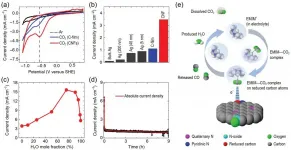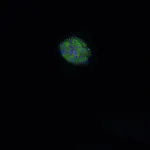(Press-News.org) This is a landmark study in so far as being the first to raise the alarm that, despite early successes with Covid-19 vaccines, further research is warranted on a next generation of Covid-19 vaccines.
The results from this study, however, only indicate that the AstraZeneca vaccine does not have at least 60% efficacy against mild-moderate Covid-19 due to the B.1.351 (N501Y.V2) variant.
Based on a broader body of evidence, the World Health Organization recommends that this vaccine still be deployed in countries where the B.1.351 variant circulates, as it likely still protects against severe infection, hospitalisation, and death caused by Covid-19.
Professor Shabir Madhi, Executive Director of the Vaccines and Infectious Diseases Analytics (VIDA) Research Unit at the University of the Witwatersrand, Johannesburg, led the trial in South Africa:
"Despite the disappointing finding that the AstraZeneca vaccine did not protect against mild Covid infection because of the B.1.351 variant first identified in South Africa, peer review and publication of our research validates the findings and makes a compelling case for the development of a second-generation vaccines worldwide," says Madhi.
First-generation vaccines refer to those designed to respond to the original SARS-CoV-2 virus. Second-generation vaccines refer to technology and design innovations that can provide protections against the constantly evolving variants that cause Covid-19 disease.
A rapid response to variant reality
The findings of this study were previously publicised as a preprint on Sunday, 7 February 2021, and concluded that the ChAdOx1 nCoV-19 vaccine provided minimal protection against mild to moderate Covid-19 infection from the B.1.351 coronavirus variant first identified in South Africa in mid-November 2020.
Prior to the evolution of the B.1.351 and P.1 variants, the South African National Department of Health (NDOH) had ordered and taken delivery of approximately one million doses of the Oxford AstraZeneca vaccine on 1 February 2021, after a published pooled analysis of this vaccine in December 2020 showed an overall vaccine efficacy of 66.7% in the UK and Brazil.
"We were in a state of euphoria about the high efficacy of several Covid-19 vaccines against the original virus, but then the AstraZeneca study threw us a curve-ball," says Madhi. "In this study now published in NEJM, we found that two doses of ChAdOx1 nCoV19 had no efficacy against non-hospitalized mild to moderate Covid-19, mainly due to the B.1.351 variant."
What the SA study published in NEJM reveals
The randomised, multi-centre, double-blinded trial enrolled 2026 participants between 24 June and 9 November 2020.
The trial was a phase 1b/11 trial that aimed to evaluate the safety, immunogenicity, and efficacy of the AstraZeneca vaccine ChAdOx1 nCoV19 in preventing symptomatic Covid-19. Immunogenicity refers to the ability of a foreign substance, such as an antigen, to provoke an immune response. Vaccine efficacy refers to the percentage reduction of a disease in a clinical trial.
"A trial enrolling just 2026 participants is considered small, while phase 3 trials enroll tens of thousands of participants," says Madhi. "Yet the startling data that our small trial generated was irrefutable, and the implications profound."
Profile of a South African AstraZenca Covid-19 vaccine trial participant
The majority of participants enrolled were relatively young (under 65-years-old), generally healthy, and HIV-negative. The median [middle] age of participants was 30 years old. More than half (56.5%) of the trial participants identified as male, 70.5% were Black Africans, 12.8% were white, and 14.9% identified as 'mixed' race.
"These demographics are important because they reflect characteristics of the overall population in South Africa. Conducting clinical trials in diverse settings like these is critical to understanding how vaccines work in local contexts," says Madhi.
Testing a hypothesis
The primary ojective of this trial was to establish this vaccine's efficacy against all-severity Covid-19, irrespective of variants.
A secondary objective was to evaluate the vaccine's efficacy against the B.1.351 variant specifically.
"When this trial began in June 2020, we were testing a vaccine against SARS-COV-2," says Madhi. "By January 2021, SARS-CoV-2 had spawned variants, including the B.1.351 first discovered in South Africa. As a secondary objective, we tested a hypothesis: would this vaccine prove at least 60% efficacious in preventing mild to moderate Covid-19 disease? It did not."
The results showed that a two-dose regimen of ChAdOx1-nCov19 did not show protection against mild to moderate Covid-19 due to the B.1.351 variant.
Crucially, Madhi notes that, "This vaccine may still help protect high-risk individuals with co-morbidities from contracting severe Covid-19 disease, having to be hospitalised, mechanically ventilated, or dying. The AstraZeneca vaccine remains essential in the arsenal against this virus, particularly in Africa, which has already received 14 million doses of this vaccine as the Covid-19 immunization programme starts in multiple countries."
How the WHO took note
On 15 February 2021, the WHO recommended that the AstraZeneca vaccine still be rolled out, even in countries where the B.1.351 variant or other similar variants of concern are circulating.
A WHO news release says that the vaccine was reviewed on 8 February by the WHO Strategic Advisory Group of Experts on Immunization (SAGE), which makes recommendations for vaccines' use in populations (i.e. recommended age groups, intervals between shots, advice for specific groups such as pregnant and lactating women). The SAGE recommended the vaccine for all age groups 18 years and above.
"While the AstraZeneca vaccine - like many other first-generation Covid-19 vaccines - is unlikely to interrupt transmission of SARS-CoV-2 or protect against mild infection from variants like B.1.351, these first-generation vaccines could still provide the only sustainable option to prevent flooding our hospitals with severe Covid-19 cases, and to mitigate Covid-19 deaths once the third wave hits," says Madhi.
Second-generation vaccine innovation
The development of an Oxford AstraZeneca and other Covid-19 vaccines targeting the B.1351 variant is currently underway.
The South African study increased awareness worldwide of the necessity of developing vaccines that target variants specifically - and even reimagining vaccines entirely.
Innovations in vaccine technologies, platforms and designs suggest exciting advances in this field.
"The finding of our [Oxford AstraZeneca Covid-19 vaccine] study are truly a turning point in Covid vaccine development - and a rude awakening," says Madhi. "This one small South African study has alerted the world to the fact that second generation Covid-19 vaccines will be required to provide protection against inevitable and persistent SARS-COV-2 variants. If we had not conducted this trial in South Africa, the world would be none the wiser."
INFORMATION:
Researchers from Skoltech and their colleagues from Hadassah Medical Center have developed hybrid nanostructured particles that can be magnetically guided to the tumor, tracked by their fluorescence and pushed to release the drug on demand by ultrasound. This technology can help make cancer chemotherapy more targeted. The paper was published in the journal Colloids and Surfaces B: Biointerfaces.Current treatments for cancer include chemotherapy, immunotherapy, radiation, and surgery, but these are often not selective enough to target just the tumor ...
The diesel engine is the backbone of transportation due to its irreplaceability as the primary power source for the freight, navigation and marine engine industries and non-road engineering machinery for the foreseeable future. However, the control of contaminants from fuel combustion has become an urgent global concern. Nitrogen oxides are the primary pollutants from transportation and can contribute to the formation of haze, photochemical smog and acid rain. Selective catalytic reduction of NOx with ammonia (NH3-SCR) technology has been successfully and commercially applied for controlling pollution from diesel vehicle exhaust. The development of ...
Electronic organic materials offer promise to support alternative and green energy sources to meet escalating global energy demands and strict environmental regulations. A KAUST-led team has now developed electron-transporting, so-called n-type, organic semiconductors that could help generate electricity from waste heat released by industrial processes and homes.
Thermoelectric generators that can convert temperature changes or gradients into electricity are highly suited for harnessing waste heat. These readily scalable devices are environmentally friendly and do not have any moving parts, which makes them ...
The use of fossil fuels as energy carriers and raw materials promotes the rapid development of the society. However, the excessive exploitation of fossil fuels gives rise to the energy crisis and undesirable environmental changes. In particular, a continuous increase of CO2 concentration in the atmosphere, which is > 400 ppm today and is estimated to triple by 2040, might result in a series of environmental issues, such as global warming, rising sea levels, and more extreme weather. Therefore, cutting CO2 emissions and developing abundant renewable energy are urgent needs and challenges for our society.
CO2 is not only one of the main greenhouse gases but also an abundant, nontoxic, nonflammable, and renewable C1 resource. Electrochemical conversion of CO2 is an attractive way to recycle ...
According to a new study published in the Journal of the Royal Society of Medicine, the carbon footprint of personal protective equipment (PPE) provided to health and social care staff in England during the first six months of the COVID-19 pandemic was equivalent to flying from London to New York 244 times every day. The good news is that adopting a range of strategies including increased UK manufacture, reusing and recycling could reduce the environmental impact of PPE dramatically while maintaining the safety of staff and patients.
The study, by Brighton and Sussex Medical School and Brighton and Sussex University Hospitals NHS Trust, found that the 3 billion items of PPE used from ...
Precision or invar alloys have been developed by scientists for many centuries. These iron and nickel-based alloys are capable of keeping their size unchanged within a given range of temperatures. Because of this, they are used in the manufacture of precision gages, standards of length, details for mechanical dial plates, and similar devices. However, invar alloys lack many other useful physical characteristics, and this limits their use in other areas, for example, those that require high thermal conductivity of materials. Therefore, scientists have long been trying to create a unique composite material based on other metals ...
Connections are crucial. Bacteria may be most dangerous when they connect - banding together to build fortress-like structures known as biofilms that afford them resistance to antibiotics. But a biomolecular scientist in Israel and a microbiologist in California have forged their own connections that could lead to new protocols for laying siege to biofilm-protected colonies. Their research was published in the Proceedings of the National Academy of Sciences (PNAS), USA.
This interdisciplinary collaboration began with a lecture given at the Weizmann Institute of Science in the Life Sciences Colloquium. Prof. Dianne Newman of the California Institute of Technology was the speaker, ...
A research breakthrough shows that a simple blood test could reduce, or in some cases replace, the need for intrusive surgery when determining the best course of treatment for patients with a specific type of brain tumour.
Researchers at the Brain Tumour Research Centre of Excellence at the University of Plymouth have discovered a biomarker which helps to distinguish whether meningioma - the most common form of adult primary brain tumour - is grade I or grade II.
The grading is significant because lower grade tumours can sometimes remain dormant for long periods, not requiring high risk surgery or harsh treatments such as radiotherapy and chemotherapy. Tumours classified as grade II can progress to become cancerous and more aggressive treatment may be needed in order ...
Many athletes, from football players to equestrians, rely on helmets to protect their heads from impacts or falls. However, a loose or improperly fitted helmet could leave them vulnerable to traumatic brain injuries (TBIs), a leading cause of death or disability in the U.S. Now, researchers reporting in ACS Sensors have developed a highly sensitive pressure sensor cap that, when worn under a helmet, could help reveal whether the headgear is a perfect fit.
According to the U.S. Centers for Disease Control and Prevention, 1.6 to 3.8 million sports- and recreation-related TBIs occur each year in the U.S. Field data suggest that loose or improperly fitted helmets can contribute ...
March 17, 2021-- A new study published online in the Annals of the American Thoracic Society reveals how socioeconomic factors partially explain the increased odds that Black and Hispanic Americans have of testing positive for SARS-CoV-2, the virus that causes COVID-19.
In "Association of Race and Ethnicity With COVID-19 Test Positivity and Hospitalization Is Mediated by Socioeconomic Factors," Hayley B. Gershengorn, MD, associate professor, Division of Pulmonary, Critical Care and Sleep Medicine, University of Miami Miller School of Medicine and co-authors ...






